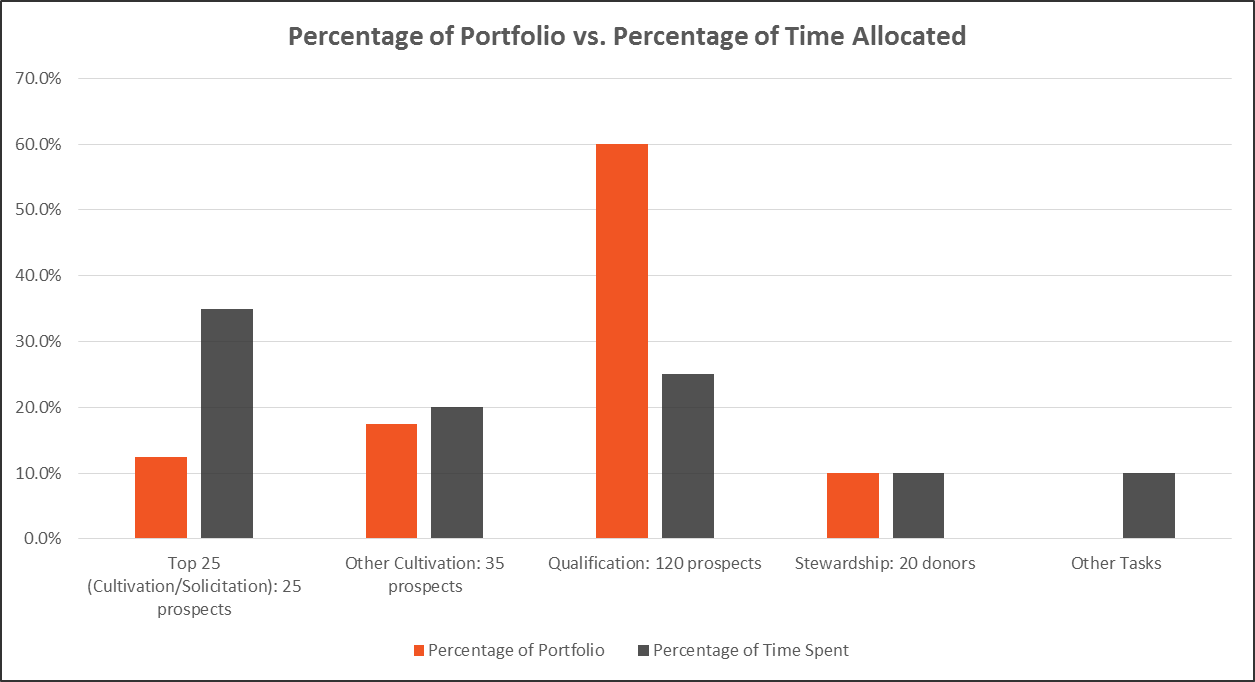
I went on a bit of a rant earlier this year. The bluster and noise was about gift officers and/or development shops with no systems and no plans. These folks are just “winging it.”
You can get caught up here if you missed it.
Cultivation, in particular, is an area where you can’t afford to wing it. It’s too important.
I’m a little ashamed to admit that I used to meander my way through major donor cultivation. And I didn’t even know it!
Sure, I had “next steps” for my prospects. And, generally, I felt pretty good about them.
What I didn’t have though were goals for my prospects – outcomes these “next steps” were moving them toward.
The result? Busywork. Spinning my wheels.
More often than not, my approach was just to invite prospects to the next thing. Oh, Bob? Haven’t seen him in a while. I’ll invite him to the next event.
Two months later: Ah, Bob…what to do with Bob? Couldn’t come to the last thing. I’ll invite him to the next thing!
Perfect example of a “ready, aim, aim, aim, aim…” approach.
Hopefully you’re in better shape with your cultivation than I was with mine. I had to learn the hard way that my approach didn’t amount to a strategy. But, there’s nothing like not raising any money to help you rethink the way you do things!
Regular Fearless Fundraising readers know where I’m going with this:
Systems! You need proven systems.
Systems help you focus. They help you keep your eye on the prize while knowing what your next move is. And, ultimately, they help you sustain the relational momentum with prospects that is so key to major gifts work.
We’ve talked plenty about systematic outreach and qualification on this blog. Today, we’ll tackle systems you can use to keep track of your cultivation efforts and ensure you’re moving prospects forward.
Here’s a cultivation experience we’ve all had: You have a great first meeting with a prospect. He’s qualified; you’re feeling good. But then six months pass. He hasn’t been out to an event and you haven’t really kept in touch. You realize that you’ve all but lost your initial momentum.
That’s not what you want to happen. Let’s set up systems to make sure it doesn’t.
Top 25
The first system I want to recommend is fairly straightforward. It’s a simple top 25 list. Who are the top 25 prospects in your portfolio? What are the top opportunities? Who’s on the “front burner,” so to speak?
Again, since we’re talking about cultivation, these are people you’ve already qualified. Another way to think about it is your 25 prospects closest to making a major gift.
If you’re a full time gift officer, this group should take up roughly one-third of your time. This is your sweet spot – it’s where you add the most value.
Here’s how I think about allocating my time with my 200-prospect portfolio:

As you can see, I spend a disproportionate amount of time on my top 25 prospects. I’ve been working this portfolio for over two years, the top 25 are all in either the cultivation or solicitation stage of the fundraising cycle, so it makes sense to spend a lot of time there. Even though I still have plenty of qualification work to do!
Now, not all portfolios are created equal. You can’t apply these time allocation percentages to every major gift portfolio at every organization. Consider the size and age of the portfolio, as well as the needs of the institution.
Here are a few takeaways for you:
- Focus on the Sweet Spot. Gift officers add maximum value by focusing a disproportionate amount of their time on their top 25.
- Make time for qualification work. You MUST continue to feed your pipeline. Some of your top 25 will not ultimately give. Some will give and move into your stewardship category. You’ll want to replace these former top 25 prospects with new ones.
- Review and revise your top 25 list at least every other week.
Cultivation Timelines
With your top 25 identified, it’s now time to plan for success. Put a system in place to make sure you have concrete goals for each prospect, as well as a path to acheiving those goals.
I start with a “best guess” ask amount, date, and project, and reverse then engineer an entire cultivation strategy for each prospect in my top 25
Yes, there may still be a number of unknowns at this point, but that’s fine. If I learned anything in graduate school, it’s that the planning process is far more important than the plan itself. Your plan will change, but sketching out a best guess and forcing yourself to go through the process of developing and end-to-end cultivation strategy will be instructive. And will keep you on track!
Here’s the simple spreadsheet I use:

Start with the prospect’s name in the left-most column.
Next, pick a target gift date and put it in one of the month columns. Here’s an example:

Remember, it’s only your best guess at this point. If I don’t have a best guess, I like to challenge myself and pencil in a year. That way I know I’m thinking aggressively and considering what it would take to make an ask after only a year of cultivation.
It’s also purposeful to pencil in a project. What do you expect you’ll be asking your prospect for when the time comes?
This too can change, but again, it helps to start off aiming at something.
So, what do we have so far? Three things: 1) Prospect’s name, 2) Target ask date, and 3) Target project.
Before working backward and reverse engineering a cultivation plan for Barbara Jones, it’s time to sketch out a learning agenda for her.
Learning Agendas
There will be two learning agendas attached to each prospect. Yours and theirs.
Your learning agenda is what you need to know about your prospect before you’re ready to make an ask.
Their learning agenda is what they’re going to want to learn about you and your organization before they’re ready to say “yes.”
Let’s start with you.
At this point, you already know your prospect has the capacity to make a major gift to your organization. But, is $50,000 the right ask amount? Or is it $5,000,000? For some prospects, you’ll have a good feel for gift range right away. For others, figuring out the right ask amount will be part of your learning agenda during cultivation.
In our example with Barbara Jones, we’re pretty confident she can pledge at least $50,000, and suspect she could go as high as $250,000 if properly cultivated. For now, we’ll add that range to the document and plan to zero in as we learn more over the coming months.
The What of your ask may also need to be part of your learning agenda. What project or initiative will you ultimately ask your prospect to support? A deeper understanding of her motivations and interests may need to be part of your learning agenda. You’ll see later on that both are part of the example learning agenda for Barbara Jones.
In the previous post, I gave an overview of Russ Alan Prince and Keren Maru File’s “Seven Faces of Philanthropy” framework. It can be helpful as you’re thinking through what motivates your prospect and how you might tailor your cultivation accordingly.
Anything else you need to know about your prospect before asking for the major gift? Add it to your learning agenda.
The final piece is typically Who. Who at your organization is the best person to ask for the gift?
So, how do you go about answering your learning agenda questions? We’ll cover that in the next two posts. For now, we’re focused developing systems to keep track of what you need to learn.
Okay, let’s talk about their learning agenda.
In the previous post I compared major gifts work to building a bridge between your organization’s mission and your prospect’s passion. Like this:

“Learning” is one of three support pillars that must be in place before you can successfully solicit a major gift. What is your prospect going to need to know before she’s ready to give to your organization? Add this information to your cultivation planning document:

In the previous post, I provided some sample questions your prospects may be asking themselves as they get to know you.
Again, we’ll talk about specific cultivation strategies and tactics designed to accomplish learning agendas – both your and theirs – in the posts to follow.
Engagement Agenda
You’ll notice on the sample planning document that there’s also a column titled “engagement agenda.”
At this point you might be thinking, Yikes, how many different agendas do I really need?
The answer: as many as it takes to get yourself thinking critically, developing solid cultivation strategies, and moving relationships forward.
The Engagement Agenda column is simply a space to pencil in the activities that will help fulfill your prospect’s learning agenda. Given the questions you believe she’s asking herself about your organization, what are you going to show her? Who are you going to introduce her to? How are you going to involve her? Add those items to your planning document:

Like all of the items in your various agendas, the things you list in your Engagement Agenda can be fluid. They will likely change as you get to know your prospect better and better.
Reverse Engineering Your Strategy
You’ve outlined what your prospect needs to learn, and you have some initial ideas for engaging her. Next, use the planning grid to reverse engineer an entire cultivation strategy.
You already have your target ask date. Start there and work backward in time to the present.
Before asking for a major gift you will typically need to develop and deliver a proposal. And before delivering a proposal, there’s a meeting or conversation to see if your prospect is ready to receive a proposal:

And there are any number of cultivation steps leading up to that point:

There are a few things I’d like to point out from this example:
- It’s currently June 2015 and this plan started by penciling in a gift from Barbara in June 2016. How do we know she’ll be ready to make a gift then? We don’t. But we’re challenging ourselves to move her from fairly early stage cultivation to solicitation in 12 months. It may indeed take longer, but let’s start by sketching out a best-case scenario and pursuing it!
- And there’s even more we don’t know! In fact, we aren’t even sure she’s interested in capital projects. Yet, we must move the relationship forward. We’re using our judgment and making a best guess given the available information. It’s okay if the plan changes as we learn more!
Calendaring
For any action items in the current month or immediate next month, add them to a calendaring system. If your donor database or CRM has a “tasks,” or “next steps” feature, use it! If not, just add the items to your Outlook calendar, Gmail calendar, or equivalent.
Now here’s the important thing: You have to commit some time to regularly revise and update this document. The last hour or two of the day on Friday works perfectly for a lot of people, but it doesn’t ultimately matter when you do it. Just be sure to schedule at least an hour a week for this type of planning.
Final Thoughts
Again, the planning process is what’s key here. It will ensure your prospect relationships move forward quickly and fewer things fall through the cracks. As a result, you’ll be positioned to take advantage of more opportunities. But, the plan itself will always be subject to change.
And don’t overthink this. Please.
The top 25 process and the cultivation planning document are just planning and organizational tools. They won’t give you 100% confidence in your next move with your prospect 100% of the time. You will need to make judgment calls; you will need to go with your gut. Using these tools will, however, give you the confidence of knowing that you’ve thought critically about your cultivation. And it will help you keep things moving forward, particularly if you commit to regular review and calendaring.
Not every prospect you cultivate will go on to make a gift. That’s why ongoing qualification work is so important. Although your top 25 will take up a disproportionate amount of your time, you still need to feed your pipeline. Otherwise you’ll stall out.
I hope this was helpful. Next, we’ll get tactical and talk about specific cultivation activities. You’ll get some fresh ideas for helping move your prospects closer and closer to making that big gift.
The post Cultivation #2 – Planning for Success appeared first on Fearless Fundraising.

















